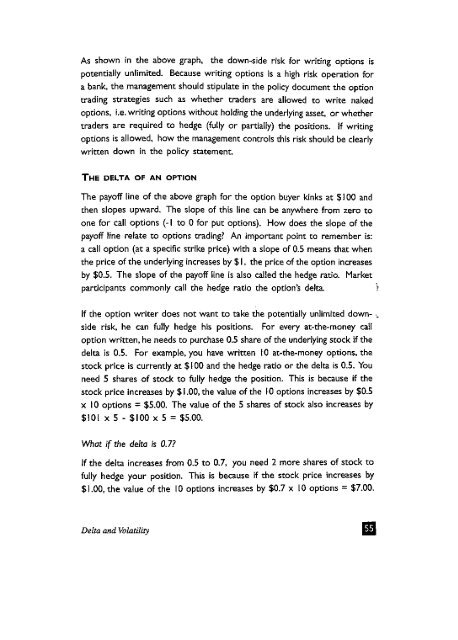Derivatives in Plain Words by Frederic Lau, with a ... - HKU Libraries
Derivatives in Plain Words by Frederic Lau, with a ... - HKU Libraries
Derivatives in Plain Words by Frederic Lau, with a ... - HKU Libraries
- No tags were found...
Create successful ePaper yourself
Turn your PDF publications into a flip-book with our unique Google optimized e-Paper software.
As shown <strong>in</strong> the above graph, the down-side risk for writ<strong>in</strong>g options ispotentially unlimited. Because writ<strong>in</strong>g options is a high risk operation fora bank, the management should stipulate <strong>in</strong> the policy document the optiontrad<strong>in</strong>g strategies such as whether traders are allowed to write nakedoptions, i.e. writ<strong>in</strong>g options <strong>with</strong>out hold<strong>in</strong>g the underly<strong>in</strong>g asset, or whethertraders are required to hedge (fully or partially) the positions. If writ<strong>in</strong>goptions is allowed, how the management controls this risk should be clearlywritten down <strong>in</strong> the policy statement.THE DELTA OF AN OPTIONThe payoff l<strong>in</strong>e of the above graph for the option buyer k<strong>in</strong>ks at $100 andthen slopes upward. The slope of this l<strong>in</strong>e can be anywhere from zero toone for call options (-1 to 0 for put options). How does the slope of thepayoff l<strong>in</strong>e relate to options trad<strong>in</strong>g? An important po<strong>in</strong>t to remember is:a call option (at a specific strike price) <strong>with</strong> a slope of 0.5 means that whenthe price of the underly<strong>in</strong>g <strong>in</strong>creases <strong>by</strong> $ I, the price of the option <strong>in</strong>creases<strong>by</strong> $0.5. The slope of the payoff l<strong>in</strong>e is also called the hedge ratio. Marketparticipants commonly call the hedge ratio the option's delta. IIf the option writer does not want to take the potentially unlimited down- vside risk, he can fully hedge his positions. For every at-the-money calloption written, he needs to purchase 0.5 share of the underly<strong>in</strong>g stock if thedelta is 0.5. For example, you have written 10 at-the-money options, thestock price is currently at $100 and the hedge ratio or the delta is 0.5. Youneed 5 shares of stock to fully hedge the position. This is because if thestock price <strong>in</strong>creases <strong>by</strong> $1.00, the value of the 10 options <strong>in</strong>creases <strong>by</strong> $0.5x 10 options = $5.00. The value of the 5 shares of stock also <strong>in</strong>creases <strong>by</strong>$101 x 5 - $100 x 5 = $5.00.What if the delta is 0.7?If the delta <strong>in</strong>creases from 0.5 to 0.7, you need 2 more shares of stock tofully hedge your position. This is because if the stock price <strong>in</strong>creases <strong>by</strong>$1.00, the value of the 10 options <strong>in</strong>creases <strong>by</strong> $0.7 x 10 options = $7.00.Delta and Volatility
















